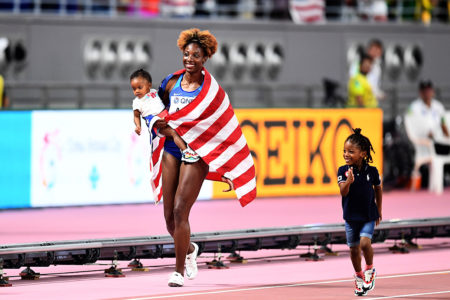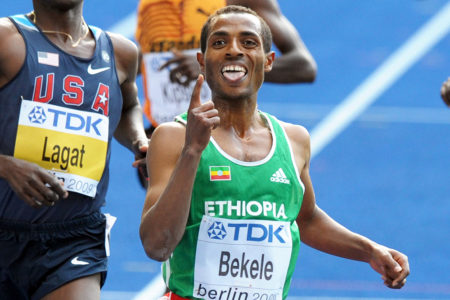
VIENNA, October 12—Running in near-ideal, overcast conditions on the streets of the Austrian capital behind a rotating phalanx of world-class pacers, Eliud Kipchoge became the first man to break the 2:00 barrier in the marathon. The 34-year-old Kenyan covered the distance in 1:59:41 (1:59:40.2, to be exact, in case you’ve seen all the erroneous time-rounded-down reporting out there) at the scientifically choreographed INEOS 1:59 Challenge.
“This was the best moment in my life,” said the Olympic champion.
Unlike Kipchoge’s effort on the auto racing track in Monza, Italy, in May ’17—in front of virtually no spectators—this production had all the feel of a major event, with crowds lining the 9.6K course along the Prater Hauptallee. Indeed, near the finish the fans were stacked 15-20 deep along the fence, creating an uproarious noise to usher the legendary runner into history. In addition, in the closing stages it was reported that there were some 750,000 viewers taking in the spectacle live on YouTube.
The pacesetter effort took the form of an inverted V formed by 5 world-class runners, with 2 more fanned out behind Kipchoge to prevent any airflow backwash from slowing him. Kipchoge ran just behind the “captain” at the point of the V. It is a counterintuitive formation, rather like a backwards flock of geese, but Nike’s scientists tested it and declared it to be the best plan.
Kipchoge, of course, also wore the latest pro version of Nike’s Vaporfly shoes, featuring a carbon fiber plate the company’s advertising for consumer models says “provides a propulsive sensation to help you push the pace.”

The pace went as smooth as a metronome, dictated by a lead car that projected green laser lines on the pavement for the two V leaders to key their stride off of. At each end of the course, the leaders lost the laser guidance as they took Kipchoge around traffic circles. The road itself had been repainted with a corridor so that Kipchoge would stay on the measured course.
There were few bumps along the way, with astonishingly even splits at each 5K. The fastest was a 14:07, the slowest 14:12. The last 5 were 14:10 on the dot. The halves were 59:54 and 59:47. The 41 pacemakers read like a who’s who of distance running. Among the notables: Matthew Centrowitz, Paul Chelimo, Lopez Lomong, Bernard Lagat and the Ingebrigtsen Brothers.
“From the first kilometer today I was really comfortable. I was really calm,” Kipchoge said. “I just wanted to maintain the pace. I followed the instructions of the pacemakers. At 35 and 40K, my mind was focused on running.”
With a kilo to go, the pace car peeled off. With 500 left, the pacesetters stepped aside so that Kipchoge could have his moment in the spotlight. As he approached the finish, he pointed at the crowd, at the clock, and mimed opening his eyes wide. He pounded his chest and crossed the line, running to the waiting arms of his wife, who had never seen him race before.
“I am the happiest man today,” he said.
The result is, of course, not eligible as a World Record—Kipchoge already holds that at 2:01:39—but it betters the 2:00:25 he ran in the Monza experiment.






